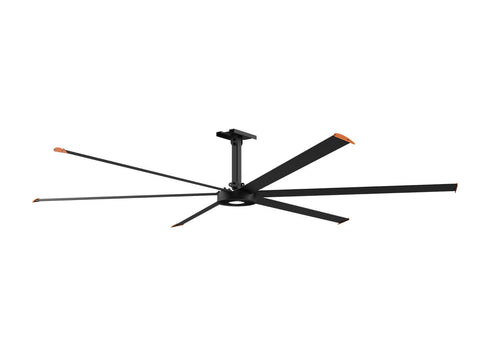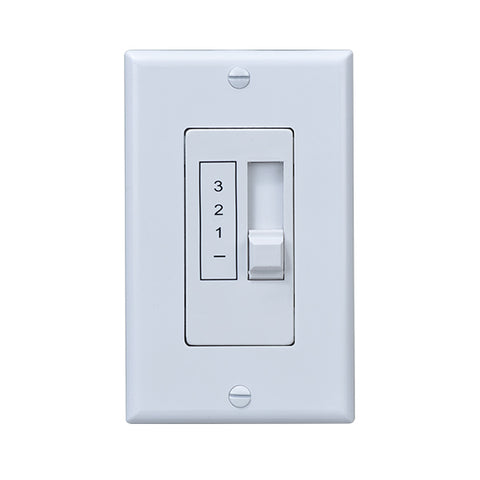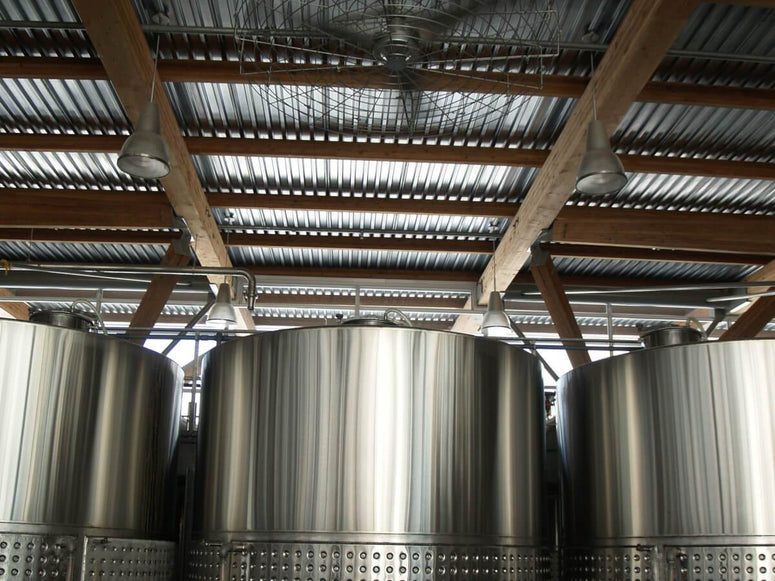While every location is different in terms of its needs, there is no denying that a ceiling fan can help keep everyone cool and comfortable. When the setting is an industrial area, the need for a fan becomes more pressing as you strive to create a work environment your employees will enjoy working in every day. This is where our industrial ceiling fan buying guide comes in! Let's take a look at some of the most important aspects to consider ensuring you get the right fan for the job.
Before we get started on how to choose the right one, the first thing to go over in an industrial ceiling fan buying guide is the difference between this fan type and residential or even commercial fans. Many people wonder if they can simply install a residential or commercial fan in their industrial setting because those tend to cost less, but this would be a bad idea for a few reasons. For starters, industrial fans are made with larger blades and a larger diameter, as well as offering more powerful motors and even different materials, such as steel, aluminum, or composite material over typical plastic or wood blades, to help the fan last longer in tougher environments or from the constant use required of an industrial fan. The most important thing to keep in mind when shopping for an industrial fan is that you choose one designs for industrial use.
Size
The matter of size when shopping for a fan is the biggest factor to keep in mind. Industrial fans can run anywhere from 56 inches in diameter to an impressively large 24 feet but a unit that large is only used in especially larger locations under certain circumstances. For the most part, 56 inches-74 inches is an acceptable size for industrial settings such as warehouses, hangers, fabrication shops, and other industrial settings. When deciding which size is best suited to your space, the size of the room is worth noting. For most spaces, a room that is smaller than 350 square feet needs a fan of 52-56 inches while any space over 350 square feet should upgrade to 60 inches for the best airflow. Of course, this is assuming you will only have one fan per room of that size. If you are looking to add more airflow to a room, you can also choose to install two fans at a safe, equal distance to help create better airflow.
Factors to Consider
It is important to note that the size is only one factor you need to consider when buying a fan. Let's take a look at a few other important aspects to keep in mind.
- People working in the space. If there are a lot of people working in the space, you may want to consider installing two or more fans. This is because the more people you have in a space, the warmer it tends to get. It's important to note however that fans are not a replacement for proper air conditioning, but rather a means to move the cool air from the ceiling down to the rest of the room where workers are present.
- Type of work being performed. The type of work being performed may also dictate the size, type, or number of fans in the space in an industrial setting. For example, if the work involves a lot of fumes or heat, you will need a higher-powered fan or multiple fans on the space to accommodate for the nature of the work.
- Mounting hardware. Fans are designed to take the air from the ceiling and circulate it down to the rest of the room. If a fan doesn't have enough room to work between the ceiling and the fan, it makes it harder for the air to circulate. Most fans are mounted on a rod extending down from the ceiling to the motor and blades, however, you want to keep in mind the size of the space and the cooling needs when looking at this aspect. A fan with a longer rod will have an easier time circulating the air over one with a shorter mounting rod which keeps the blades too close to the ceiling.
- Motor. Motors in industrial fans are either AC or DC and the difference is an important factor to consider. An AC motor or alternating current plugs directly into a power source or plug which allows it the ability to reverse currents so the current runs between the power source and the fan motor. A DC or direct current are plugged into a transformer which then connects to the power source or plug. An AC motor is less efficient in terms of energy consumed over DC motors which is why many businesses choose DC, but if there are other reasons associated to your decision, an AC motor is still a reliable choice provided you are only looking to install a few fans rather than a few dozen fans.
- Airflow rating and CFM. The air flow rating is measured in cubic feet per minute or CFM. This figure indicates the volume or amount of air the fan can move per minute. It's important to keep this in mind because the larger the space, the lower the time frame should be to ensure it is capable of moving the air around for proper air circulation. To find the right airflow rating for the size of your space, divide the size of the room in cubic feet by the suggested CFM of the fan as specified by the manufacturer. You want it to be less than 5 minutes for the air to circulate to avoid the space becoming hot and stagnant.
- Wind Speed. The wind speed is essentially how fast a fan can move air down to the ground and this factor needs to be considered. While this is also partly calculated into the CFM, you still need to consider it based on the work area. For example, a fan with a high wind speed wouldn't be ideal in a location where a fast fan could cause things to blow away such as papers whereas a fan in an area with a lot of fumes or heat would benefit from a faster wind speed.
 High Bay LED Lighting
High Bay LED Lighting
 Industrial Low Bay Lighting
Industrial Low Bay Lighting
 Industrial Strip Lights
Industrial Strip Lights
 Vapor Tight Lighting
Vapor Tight Lighting
 LED Shop Lights
LED Shop Lights
 Hazardous Area / Explosion Proof Lighting
Hazardous Area / Explosion Proof Lighting
 Loading Dock Lights
Loading Dock Lights
 Construction / Portable Lighting
Construction / Portable Lighting
 Industrial Ceiling Fans
Industrial Ceiling Fans
 LED Work Lights
LED Work Lights
 Networked Controlled Lighting
Networked Controlled Lighting
 NEW Warehouse Lighting Fixtures
NEW Warehouse Lighting Fixtures
 American Made Industrial Lighting
American Made Industrial Lighting
 Clearance
Clearance
 Troffer Lights
Troffer Lights
 LED Flat Panel Lights
LED Flat Panel Lights
 Drop Ceiling Lights
Drop Ceiling Lights
 Suspended LED Lights
Suspended LED Lights
 LED Cylinder Lights
LED Cylinder Lights
 Exit / Emergency
Exit / Emergency
 Wrap Lighting Fixtures
Wrap Lighting Fixtures
 Gooseneck and Barn Lights
Gooseneck and Barn Lights
 Stairway & Corridor Lighting
Stairway & Corridor Lighting
 Hospital Bed Lights
Hospital Bed Lights
 Recessed Lighting
Recessed Lighting
 Wafer Lighting
Wafer Lighting
 RGB LED Lights
RGB LED Lights
 Grow Lights
Grow Lights
 Refrigeration Lighting
Refrigeration Lighting
 Commercial Sign Lights
Commercial Sign Lights
 LED Track Lighting Fixtures & Systems
LED Track Lighting Fixtures & Systems
 UV Disinfecting Lights & Air Purifier Fixtures
UV Disinfecting Lights & Air Purifier Fixtures
 American Made Commercial Lighting
American Made Commercial Lighting
 LED Flood Lights
LED Flood Lights
 Outdoor Wall Lights
Outdoor Wall Lights
 LED Area Lights
LED Area Lights
 Parking Lot Lights & Poles
Parking Lot Lights & Poles
 Outdoor Post Top Lights
Outdoor Post Top Lights
 LED Stadium Lighting
LED Stadium Lighting
 Canopy Lights
Canopy Lights
 Security & Motion Sensor Lights
Security & Motion Sensor Lights
 LED Bollard Lights
LED Bollard Lights
 Outdoor LED Linear Light Fixtures
Outdoor LED Linear Light Fixtures
 Solar Powered LED Lighting
Solar Powered LED Lighting
 Dusk to Dawn Lights
Dusk to Dawn Lights
 Landscape Lighting
Landscape Lighting
 Outdoor String Lights
Outdoor String Lights
 Coastal Wildlife Lighting
Coastal Wildlife Lighting
 Outdoor House Lights
Outdoor House Lights
 American Made Outdoor Lighting
American Made Outdoor Lighting
 Architectural Linear Lights
Architectural Linear Lights
 Architectural Grid Mount Lights
Architectural Grid Mount Lights
 Architectural Round Pendant Lights
Architectural Round Pendant Lights
 Architectural Square Linear Lights
Architectural Square Linear Lights
 Architectural X-Shaped Linear Lights
Architectural X-Shaped Linear Lights
 Architectural LED Wall Packs
Architectural LED Wall Packs
 Ceiling Fans
Ceiling Fans
 Ceiling Lights
Ceiling Lights
 Chandelier Lights
Chandelier Lights
 Pendant Lighting
Pendant Lighting
 Island Lights
Island Lights
 Under Cabinet Lighting
Under Cabinet Lighting
 Vanity Lights
Vanity Lights
 Wall Sconces
Wall Sconces
 LED Tape Lights
LED Tape Lights
 LED Mirrors
LED Mirrors
 LED Light Bulbs
LED Light Bulbs
 LED Tube Lights
LED Tube Lights
 LED Corn Lights
LED Corn Lights
 Vintage LED Bulbs
Vintage LED Bulbs
 Decorative LED Bulbs
Decorative LED Bulbs
 Fluorescent Light Bulbs
Fluorescent Light Bulbs
 Metal Halide Lamps
Metal Halide Lamps
 LED Magnetic Strip Retrofit Kits
LED Magnetic Strip Retrofit Kits
 LED Strip Light Retrofit Kits
LED Strip Light Retrofit Kits
 High Bay LED Retrofit Kits
High Bay LED Retrofit Kits
 LED Troffer Retrofit Kits
LED Troffer Retrofit Kits
 LED Wall Pack Retrofit
LED Wall Pack Retrofit
 LED Street Light Retrofit Kits
LED Street Light Retrofit Kits
 Recessed Lighting LED Retrofit Kits
Recessed Lighting LED Retrofit Kits
 Ballasts & Drivers
Ballasts & Drivers
 Emergency Ballast For LED & Fluorescent Lights
Emergency Ballast For LED & Fluorescent Lights
 Electrical Supplies & Mounting Kits
Electrical Supplies & Mounting Kits
 Electrical Tools
Electrical Tools
 Switches & Receptacles
Switches & Receptacles
 Electrical Power Cords
Electrical Power Cords
 Sensors and Timers
Sensors and Timers
 Smart Home Automation
Smart Home Automation
 High Bay Occupancy Sensors
High Bay Occupancy Sensors
 Electric Vehicle Chargers
Electric Vehicle Chargers
 Hand Dryers
Hand Dryers
 LED Shop Lights
LED Shop Lights
 Garage LED Light Fixtures
Garage LED Light Fixtures
 Office Lights
Office Lights
 Classroom Lights
Classroom Lights
 Church Lights
Church Lights
 Gym Lighting
Gym Lighting
 Factory Lights
Factory Lights
 Hospital Lights
Hospital Lights
 Walkway Lights
Walkway Lights
 Parking Lot Lights
Parking Lot Lights
 Exterior Building Lights
Exterior Building Lights
 Sports Lighting
Sports Lighting
 Airport Lights
Airport Lights
 NSF Rated Lights
NSF Rated Lights
 Restaurant Lights
Restaurant Lights
 Corridor Lights
Corridor Lights
 Barn Lighting
Barn Lighting







